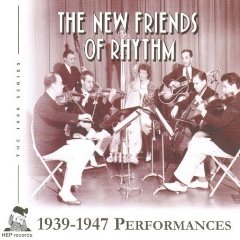 Most jazz musicians have had at least some experience playing classical music, but it’s unusual for them to record it. When they do, it tends to be in the form of the jazzing-the-classics adaptations that I wrote about in a 2007 “Sightings” column for The Wall Street Journal occasioned by the first reissue of the rare 78s of a wonderful little combo called the New Friends of Rhythm:
Most jazz musicians have had at least some experience playing classical music, but it’s unusual for them to record it. When they do, it tends to be in the form of the jazzing-the-classics adaptations that I wrote about in a 2007 “Sightings” column for The Wall Street Journal occasioned by the first reissue of the rare 78s of a wonderful little combo called the New Friends of Rhythm:
The New Friends of Rhythm was an instrumental septet led by Alan Shulman, a cellist and composer who was a charter member of Arturo Toscanini’s NBC Symphony. It consisted of a harpist, a string quartet and a jazz rhythm section, and it played very hip arrangements of well-known pieces of classical music to which Shulman affixed such zany titles as “Bach Bay Blues” and “Shoot the Schubert to Me, Hubert.” The group’s records were so successful that in 1940 it got written up in Time, which revealed that its members were known at NBC as “Toscanini’s hep cats.”
In those days, of course, the classics got jazzed on a regular basis. Some of the most popular songs of the ’30s and ’40s, including “The Lamp Is Low” and “My Reverie,” were based on such classical compositions as Ravel’s “Pavane for a Dead Princess” and Debussy’s “Rêverie.” The practice became so common that Ayn Rand, whose virtues are not known to have included a sense of humor, took a shot at it in Atlas Shrugged, in which she grumpily described an imaginary pop record based on a piano concerto by a fictional composer named Richard Halley: “It was as if a handful of mud and pebbles had been flung at the music, and what followed was the sound of the rolling and the dripping….It was Halley’s melody torn apart, its holes stuffed with hiccoughs. The great statement of joy had become the giggling of a barroom.”
The real-life record Rand undoubtedly had in mind was Freddy Martin’s “Concerto in B Flat,” based on the first movement of the Tchaikovsky B-Flat Minor Piano Concerto, which was one of the biggest sellers of 1941. It is, if truth be told, pretty sappy. But when bona fide jazz musicians reworked the classics, the results could be delightful. Art Tatum’s dapper stride-piano version of Dvorak’s “Humoresque” (which you can see him playing on YouTube) is as elegant as a tightly rolled umbrella, while the King Cole Trio’s recording of Rachmaninoff’s Prelude in C-Sharp Minor is one of the most ingenious jazz arrangements of a classic ever to be committed to disc….
“Humoresque,” needless to say, wasn’t Tatum’s only recorded excursion into the classics, and I’d heard for years that on occasion he even played Chopin. In 2006 Storyville Records confirmed the rumor by releasing an album that contained a highly personal reinterpretation of Chopin’s C-Sharp Minor Waltz, Op. 64/2, recorded in a Toronto nightclub in 1949. Now some anonymous benefactor has posted that audio-only track on YouTube, and it proves, not surprisingly, to be a fascinating and treasurable document of Tatum’s style.
Here it is:
